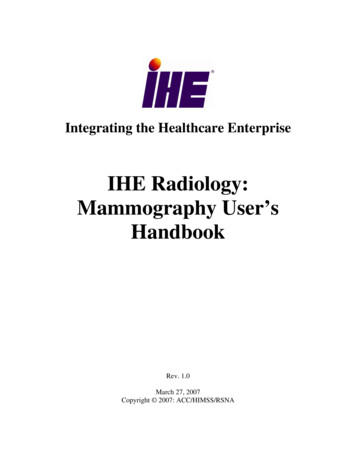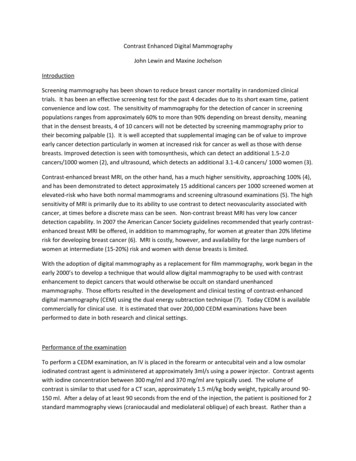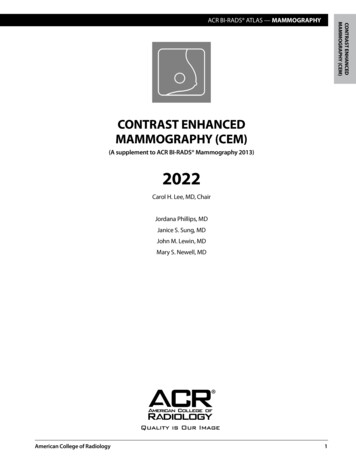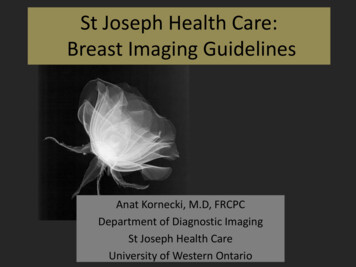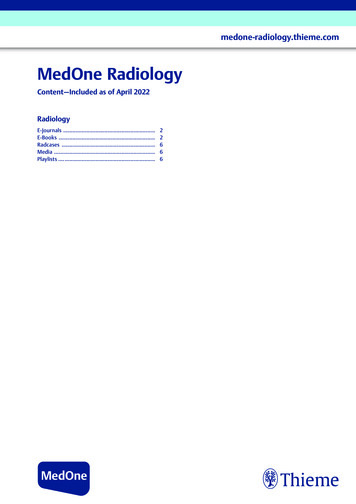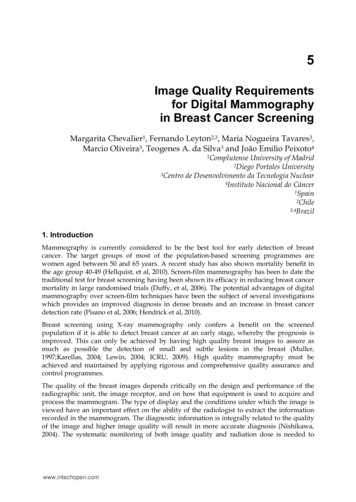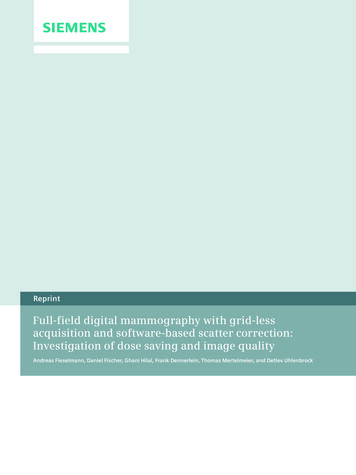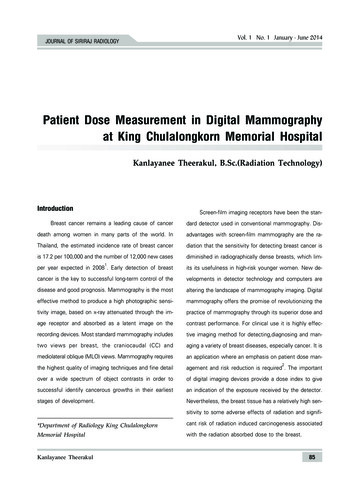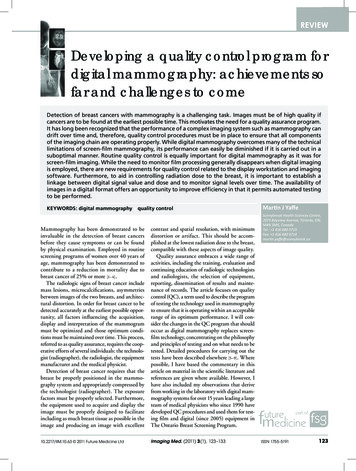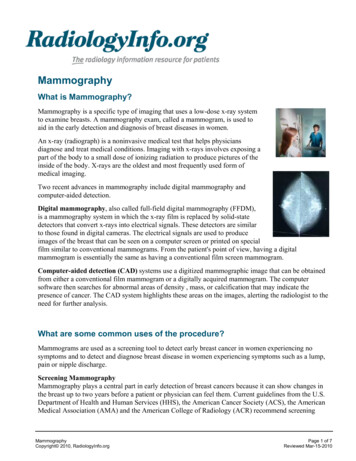
Transcription
MammographyWhat is Mammography?Mammography is a specific type of imaging that uses a low-dose x-ray systemto examine breasts. A mammography exam, called a mammogram, is used toaid in the early detection and diagnosis of breast diseases in women.An x-ray (radiograph) is a noninvasive medical test that helps physiciansdiagnose and treat medical conditions. Imaging with x-rays involves exposing apart of the body to a small dose of ionizing radiation to produce pictures of theinside of the body. X-rays are the oldest and most frequently used form ofmedical imaging.Two recent advances in mammography include digital mammography andcomputer-aided detection.Digital mammography, also called full-field digital mammography (FFDM),is a mammography system in which the x-ray film is replaced by solid-statedetectors that convert x-rays into electrical signals. These detectors are similarto those found in digital cameras. The electrical signals are used to produceimages of the breast that can be seen on a computer screen or printed on specialfilm similar to conventional mammograms. From the patient's point of view, having a digitalmammogram is essentially the same as having a conventional film screen mammogram.Computer-aided detection (CAD) systems use a digitized mammographic image that can be obtainedfrom either a conventional film mammogram or a digitally acquired mammogram. The computersoftware then searches for abnormal areas of density , mass, or calcification that may indicate thepresence of cancer. The CAD system highlights these areas on the images, alerting the radiologist to theneed for further analysis.What are some common uses of the procedure?Mammograms are used as a screening tool to detect early breast cancer in women experiencing nosymptoms and to detect and diagnose breast disease in women experiencing symptoms such as a lump,pain or nipple discharge.Screening MammographyMammography plays a central part in early detection of breast cancers because it can show changes inthe breast up to two years before a patient or physician can feel them. Current guidelines from the U.S.Department of Health and Human Services (HHS), the American Cancer Society (ACS), the AmericanMedical Association (AMA) and the American College of Radiology (ACR) recommend screeningMammographyCopyright 2010, RadiologyInfo.orgPage 1 of 7Reviewed Mar-15-2010
mammography every year for women, beginning at age 40. Research has shown that annualmammograms lead to early detection of breast cancers, when they are most curable andbreast-conservation therapies are available.The National Cancer Institute (NCI) adds that women who have had breast cancer and those who are atincreased risk due to a genetic history of breast cancer should seek expert medical advice about whetherthey should begin screening before age 40 and about the frequency of screening.See the Breast Cancer page (www.RadiologyInfo.org/en/info.cfm?pg breastcancer) for informationabout breast cancer therapy.Diagnostic MammographyDiagnostic mammography is used to evaluate a patient with abnormal clinical findings—such as abreast lump or lumps—that have been found by the woman or her doctor. Diagnostic mammographymay also be done after an abnormal screening mammography in order to evaluate the area of concern onthe screening exam.How should I prepare?Before scheduling a mammogram, the American Cancer Society (ACS) and other specialtyorganizations recommend that you discuss any new findings or problems in your breasts with yourdoctor. In addition, inform your doctor of any prior surgeries, hormone use, and family or personalhistory of breast cancer.Do not schedule your mammogram for the week before your period if your breasts are usually tenderduring this time. The best time for a mammogram is one week following your period. Always informyour doctor or x-ray technologist if there is any possibility that you are pregnant.The ACS also recommends you:Do not wear deodorant, talcum powder or lotion under your arms or on your breasts on the day ofthe exam. These can appear on the mammogram as calcium spots.Describe any breast symptoms or problems to the technologist performing the exam.If possible, obtain prior mammograms and make them available to the radiologist at the time ofthe current exam.Ask when your results will be available; do not assume the results are normal if you do not hearfrom your doctor or the mammography facility.What does the equipment look like?A mammography unit is a rectangular box that houses the tube in which x-raysare produced. The unit is used exclusively for x-ray exams of the breast, withspecial accessories that allow only the breast to be exposed to the x-rays.Attached to the unit is a device that holds and compresses the breast andpositions it so images can be obtained at different angles.MammographyCopyright 2010, RadiologyInfo.orgPage 2 of 7Reviewed Mar-15-2010
How does the procedure work?X-rays are a form of radiation like light or radio waves.X-rays pass through most objects, including the body.Once it is carefully aimed at the part of the body beingexamined, an x-ray machine produces a small burst ofradiation that passes through the body, recording animage on photographic film or a special digital imagerecording plate.Different parts of the body absorb the x-rays in varyingdegrees. Dense bone absorbs much of the radiationwhile soft tissue, such as muscle, fat and organs, allow more of the x-rays to pass through them. As aresult, bones appear white on the x-ray, soft tissue shows up in shades of gray and air appears black.Until recently, x-ray images were maintained as hard film copy (much like a photographic negative).Today, most images are digital files that are stored electronically. These stored images are easilyaccessible and are frequently compared to current x-ray images for diagnosis and disease management.How is the procedure performed?Mammography is performed on an outpatient basis.During mammography, a specially qualified radiologic technologist will position your breast in themammography unit. Your breast will be placed on a special platform and compressed with a paddle(often made of clear Plexiglas or other plastic). The technologist will gradually compress your breast.Breast compression is necessary in order to:Even out the breast thickness so that all of the tissue can be visualized.Spread out the tissue so that small abnormalities are less likely to beobscured by overlying breast tissue.Allow the use of a lower x-ray dose since a thinner amount of breast tissueis being imaged.Hold the breast still in order to minimize blurring of the image caused bymotion.Reduce x-ray scatter to increase sharpness of picture.You will be asked to change positions between images. The routine views are a top-to-bottom view andan oblique side view. The process will be repeated for the other breast.You must hold very still and may be asked to keep from breathing for a few seconds while the x-raypicture is taken to reduce the possibility of a blurred image. The technologist will walk behind a wall orinto the next room to activate the x-ray machine.When the examination is complete, you will be asked to wait until the radiologist determines that all thenecessary images have been obtained.The examination process should take about 30 minutes.MammographyCopyright 2010, RadiologyInfo.orgPage 3 of 7Reviewed Mar-15-2010
What will I experience during and after the procedure?You will feel pressure on your breast as it is squeezed by the compression paddle. Some women withsensitive breasts may experience discomfort. If this is the case, schedule the procedure when yourbreasts are least tender. Be sure to inform the technologist if pain occurs as compression is increased. Ifdiscomfort is significant, less compression will be used.Who interprets the results and how do I get them?A radiologist, a physician specifically trained to supervise and interpret radiology examinations, willanalyze the images and send a signed report to your primary care or referring physician, who willdiscuss the results with you.You will also be notified of the results by the mammography facility.What are the benefits vs. risks?BenefitsImaging of the breast improves a physician's ability to detect small tumors. When cancers aresmall, the woman has more treatment options and a cure is more likely.The use of screening mammography increases the detection of small abnormal tissue growthsconfined to the milk ducts in the breast, called ductal carcinoma in situ (DCIS). These earlytumors cannot harm patients if they are removed at this stage and mammography is the onlyproven method to reliably detect these tumors. It is also useful for detecting all types of breastcancer, including invasive ductal and invasive lobular cancer.No radiation remains in a patient's body after an x-ray examination.X-rays usually have no side effects in the diagnostic range.RisksThere is always a slight chance of cancer from excessive exposure to radiation. However, thebenefit of an accurate diagnosis far outweighs the risk.The effective radiation dose from a mammogram is about 0.7 mSv, which is about the same asthe average person receives from background radiation in three months. Federal mammographyguidelines require that each unit be checked by a medical physicist every year to ensure that theunit operates correctly. See the Safety page (www.RadiologyInfo.org/en/safety/) for moreinformation about radiation dose.False Positive Mammograms. Five percent to 15 percent of screening mammograms require moretesting such as additional mammograms or ultrasound. Most of these tests turn out to be normal.If there is an abnormal finding, a follow-up or biopsy may have to be performed. Most of thebiopsies confirm that no cancer was present. It is estimated that a woman who has yearlymammograms between ages 40 and 49 has about a 30 percent chance of having a false-positivemammogram at some point in that decade and about a 7 percent to 8 percent chance of having aMammographyCopyright 2010, RadiologyInfo.orgPage 4 of 7Reviewed Mar-15-2010
breast biopsy within the 10-year period.Women should always inform their physician or x-ray technologist if there is any possibility thatthey are pregnant. See the Safety page (www.RadiologyInfo.org/en/safety/) for more informationabout pregnancy and x-rays.A Word About Minimizing Radiation ExposureSpecial care is taken during x-ray examinations to use the lowest radiation dose possible whileproducing the best images for evaluation. National and international radiology protection councilscontinually review and update the technique standards used by radiology professionals.State-of-the-art x-ray systems have tightly controlled x-ray beams with significant filtration and dosecontrol methods to minimize stray or scatter radiation. This ensures that those parts of a patient's bodynot being imaged receive minimal radiation exposure.What are the limitations of Mammography?Initial mammographic images themselves are not usually enough to determine the existence of a benignor malignant disease with certainty. If a finding or spot seems suspicious, your radiologist mayrecommend further diagnostic studies.Interpretations of mammograms can be difficult because a normal breast can appear differently for eachwoman. Also, the appearance of an image may be compromised if there is powder or salve on thebreasts or if you have undergone breast surgery. Because some breast cancers are hard to visualize, aradiologist may want to compare the image to views from previous examinations. Not all cancers of thebreast can be seen on mammography.Breast implants can also impede accurate mammogram readings because both silicone and salineimplants are not transparent on x-rays and can block a clear view of the tissues behind them, especiallyif the implant has been placed in front of, rather than beneath, the chest muscles Experiencedtechnologists and radiologists know how to carefully compress the breasts to improve the view withoutrupturing the implant.When making an appointment for a mammogram, women with implants should ask if the facility usesspecial techniques designed to accommodate them. Before the mammogram is taken, they should makesure the technologist is experienced in performing mammography on patients with breast implants.While mammography is the best screening tool for breast cancer available today, mammograms do notdetect all breast cancers. Also, a small portion of mammograms indicate that a cancer could possibly bepresent when it is not (called a false-positive result).Research is being done on a variety of breast imaging techniques that can contribute to the earlydetection of breast cancer and improve the accuracy in distinguishing non-cancerous breast conditionsfrom breast cancers.Additional Mammography Information and Resources:RadiologyInfoMammographyCopyright 2010, RadiologyInfo.orgPage 5 of 7Reviewed Mar-15-2010
Breast Cancer:www.RadiologyInfo.org/en/info.cfm?pg breastcancerNew American Cancer Society Guidelines for Breast Screening with MRI in addition to Mammographyreleased March 28th, ?id 14Digital Mammography Superior to Film Mammography for Some Women:www.RadiologyInfo.org/en/news/target.cfm?ID 343'Stereo' Mammography Takes Breast Imaging to a New ?ID 341Attitudes Toward Mammography Differ Across Ethnicities, Cultures, fm?ID 331Access to Prior Mammograms Helps Radiologists Detect Breast Cancer:www.RadiologyInfo.org/en/news/target.cfm?ID 306Results of Large Trial Reveal Certain Women Could Benefit from Digital get.cfm?id 3RTAnswers.orgRadiation Therapy for Breast w.nlm.nih.gov/medlineplus/mammography.htmlAmerican Cancer SocietyMammograms and other Breast Imaging Procedures:www.cancer.org/docroot/CRI/content/CRI 2 6X Mammography andother Breast Imaging Procedures 5.aspDisclaimerThis information is copied from the RadiologyInfo Web site (http://www.radiologyinfo.org) which is dedicated to providingthe highest quality information. To ensure that, each section is reviewed by a physician with expertise in the area presented.All information contained in the Web site is further reviewed by an ACR (American College of Radiology) - RSNA(Radiological Society of North America) committee, comprising physicians with expertise in several radiologic areas.However, it is not possible to assure that this Web site contains complete, up-to-date information on any particular subject.Therefore, ACR and RSNA make no representations or warranties about the suitability of this information for use for anyparticular purpose. All information is provided "as is" without express or implied warranty.Please visit the RadiologyInfo Web site at http://www.radiologyinfo.org to view or download the latest information.Note: Images may be shown for illustrative purposes. Do not attempt to draw conclusions or make diagnoses by comparingthese images to other medical images, particularly your own. Only qualified physicians should interpret images; theradiologist is the physician expert trained in medical imaging.MammographyCopyright 2010, RadiologyInfo.orgPage 6 of 7Reviewed Mar-15-2010
CopyrightThis material is copyrighted by either the Radiological Society of North America (RSNA), 820 Jorie Boulevard, Oak Brook,IL 60523-2251 or the American College of Radiology (ACR), 1891 Preston White Drive, Reston, VA 20191-4397.Commercial reproduction or multiple distribution by any traditional or electronically based reproduction/publication methodis prohibited.Copyright 2010 Radiological Society of North America, Inc.MammographyCopyright 2010, RadiologyInfo.orgPage 7 of 7Reviewed Mar-15-2010
Digital mammography, also called full-field digital mammography (FFDM), is a mammography system in which the x-ray film is replaced by solid-state detectors that convert x-rays into electrical signals. These detectors are similar to those found in digital cameras. The electrical signals are used to produce
